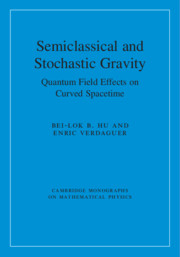Book contents
- Frontmatter
- Dedication
- Contents
- Preface
- 1 Overview: Main Themes. Key Issues. Reader’s Guide
- Part I Effective Action and Regularization, Stress Tensor and Fluctuations
- Part II Infrared Behavior, 2PI, I/N, Backreaction and Semiclassical Gravity
- Part III Stochastic Gravity
- Part IV Cosmological and Black Hole Backreaction with Fluctuations
- Part V Quantum Curvature Fluctuations in de Sitter Spacetime
- 15 Stress-Energy Tensor Fluctuations in de Sitter Space
- 16 Two-Point Metric Perturbations in de Sitter
- 17 Riemann Tensor Correlator in de Sitter
- 18 Epilogue: Linkage with Quantum Gravity
- References
- Index
18 - Epilogue: Linkage with Quantum Gravity
from Part V - Quantum Curvature Fluctuations in de Sitter Spacetime
Published online by Cambridge University Press: 20 January 2020
- Frontmatter
- Dedication
- Contents
- Preface
- 1 Overview: Main Themes. Key Issues. Reader’s Guide
- Part I Effective Action and Regularization, Stress Tensor and Fluctuations
- Part II Infrared Behavior, 2PI, I/N, Backreaction and Semiclassical Gravity
- Part III Stochastic Gravity
- Part IV Cosmological and Black Hole Backreaction with Fluctuations
- Part V Quantum Curvature Fluctuations in de Sitter Spacetime
- 15 Stress-Energy Tensor Fluctuations in de Sitter Space
- 16 Two-Point Metric Perturbations in de Sitter
- 17 Riemann Tensor Correlator in de Sitter
- 18 Epilogue: Linkage with Quantum Gravity
- References
- Index
Summary
In this epilogue we place the theories of semiclassical and stochastic gravity in perspective, exploring their linkage with quantum gravity, defined as theories for the microscopic structures of spacetime, not necessarily and most likely not from quantizing general relativity. We distinguish two categorical approaches, ‘top-down’ (Planck energy) and ‘bottom-up’. The tasks of the ‘top-down’ approach, which include string theory and other proposed theories for the microstructures of spacetime, lie in explaining how the micro-constituents give rise to macroscopic structure. They are thus more appropriately called emergent gravity. warnings are issued not to blindly follow the dogma that quantizing general relativity naturally yields a microscopic structure of spacetime, or to accept, without checking the emergent mechanisms, the dictum that some micro-constituent is the theory that gives us everything. Stochastic gravity takes the more conservative ‘bottom-up’ approach. For the linkage with quantum gravity we mention (a) the kinetic theory approach, relying on the structure of a correlation hierarchy and the role played by noise and fluctuations, and (b) the effective theory approach, using large N techniques. The ingredients of both approaches have been developed in earlier chapters systematically. We end with a description of the advantages and limitations of stochastic gravity.
Information
- Type
- Chapter
- Information
- Semiclassical and Stochastic GravityQuantum Field Effects on Curved Spacetime, pp. 540 - 549Publisher: Cambridge University PressPrint publication year: 2020
